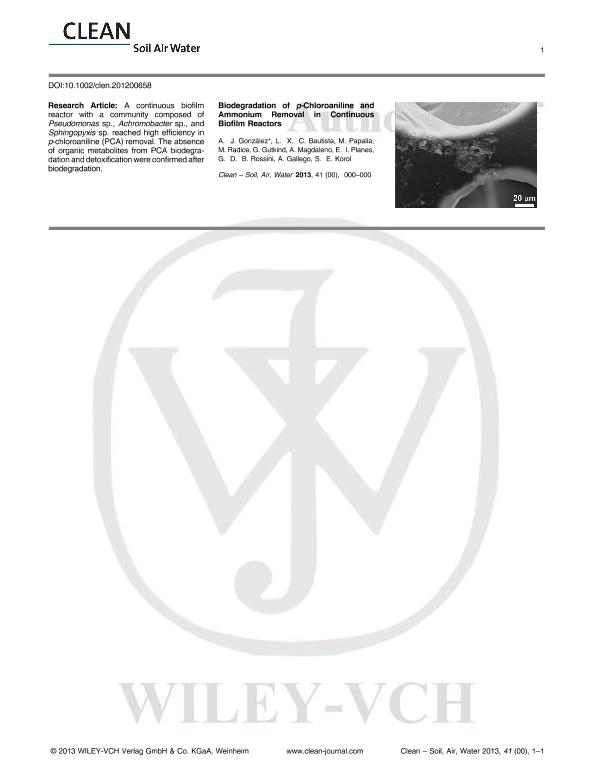Artículo
Biodegradation of p-Chloroaniline and Ammonium Removal in Continuous Biofilm Reactors
González, Ana Julieta ; Celis Bautista, Lina X.; Papalia, Mariana Andrea
; Celis Bautista, Lina X.; Papalia, Mariana Andrea ; Radice, Marcela Alejandra
; Radice, Marcela Alejandra ; Gutkind, Gabriel Osvaldo
; Gutkind, Gabriel Osvaldo ; Magdaleno, Anahí
; Magdaleno, Anahí ; Planes, Estela I.; Bulus Rossini, Gustavo Daniel; Gallego, Alfredo; Korol, Sonia E.
; Planes, Estela I.; Bulus Rossini, Gustavo Daniel; Gallego, Alfredo; Korol, Sonia E.
 ; Celis Bautista, Lina X.; Papalia, Mariana Andrea
; Celis Bautista, Lina X.; Papalia, Mariana Andrea ; Radice, Marcela Alejandra
; Radice, Marcela Alejandra ; Gutkind, Gabriel Osvaldo
; Gutkind, Gabriel Osvaldo ; Magdaleno, Anahí
; Magdaleno, Anahí ; Planes, Estela I.; Bulus Rossini, Gustavo Daniel; Gallego, Alfredo; Korol, Sonia E.
; Planes, Estela I.; Bulus Rossini, Gustavo Daniel; Gallego, Alfredo; Korol, Sonia E.
Fecha de publicación:
04/2014
Editorial:
Wiley VCH Verlag
Revista:
Clean Soil, Air, Water
ISSN:
1863-0669
Idioma:
Inglés
Tipo de recurso:
Artículo publicado
Clasificación temática:
Resumen
In this investigation, we isolated from an industrial effluent a bacterial community capable of utilizing p-chloroaniline (PCA) as the sole source of carbon and nitrogen. The isolates were identified as Pseudomonas sp., Achromobacter sp., and Sphingopyxis sp. The bacterial community was employed to set up a continuous system for PCA degradation and ammonium removal. The system consists in two sequential aerobic fixed-bed reactors, for PCA biodegradation and nitrification respectively, and an anoxic reactor for denitrification. Biodegradation process was evaluated by chemical analysis of PCA, chloride and ammonium, and bacterial count. Nitrification and denitrification processes were evaluated by chemical analysis of ammonium, nitrite and nitrate, and nitrifying bacteria count. Bioassays of acute toxicity using the standard organisms Vibrio fischeri, Pseudokirchneriella subcapitata, and Daphnia magna were performed in order to assess detoxification. An average efficiency of 88.5%, expressed as PCA removal, was achieved in the biodegradation process. The maximum PCA removal rate reached 11.7 g/m3 day. PCA degradation was associated with the release of chloride and ammonium. Ammonium was completely removed by the nitrification/denitrification process. Toxicity was not detected after the biodegradation process.
Archivos asociados
Licencia
Identificadores
Colecciones
Articulos(OCA HOUSSAY)
Articulos de OFICINA DE COORDINACION ADMINISTRATIVA HOUSSAY
Articulos de OFICINA DE COORDINACION ADMINISTRATIVA HOUSSAY
Citación
González, Ana Julieta; Celis Bautista, Lina X.; Papalia, Mariana Andrea; Radice, Marcela Alejandra; Gutkind, Gabriel Osvaldo; et al.; Biodegradation of p-Chloroaniline and Ammonium Removal in Continuous Biofilm Reactors; Wiley VCH Verlag; Clean Soil, Air, Water; 42; 4; 4-2014; 449-455
Compartir
Altmétricas



